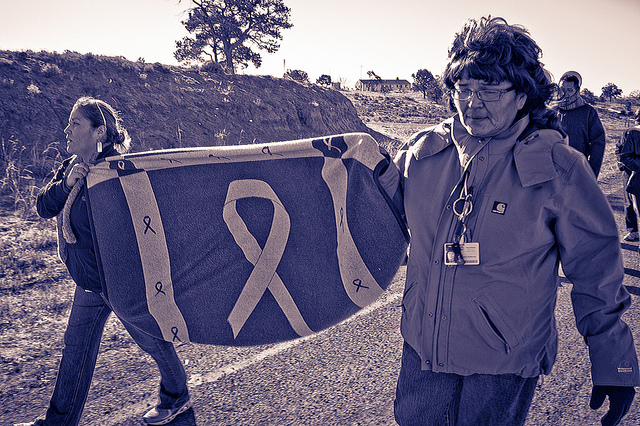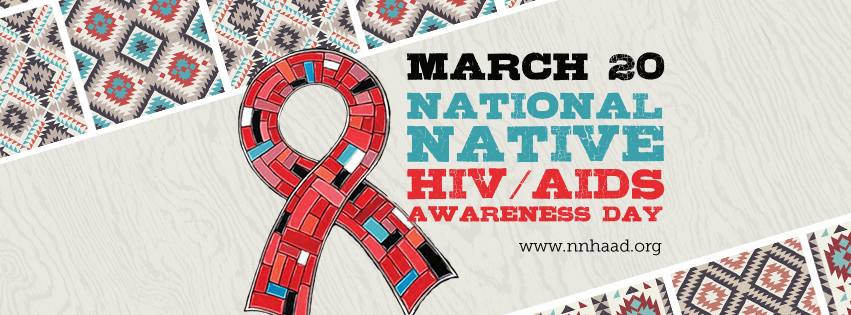As we continue learning how to live with the effects of the COVID-19 pandemic, there is another disease that has not yet been defeated: HIV/AIDS.
The CDC estimates that 3,000 American Indians and/or Alaska Natives are living with HIV. The Indian Health Service reported that only 21 percent of urban Native patients had been tested for HIV at urban Indian health programs at some point in their lives. American Indians and Alaska Natives represent about 1.3 percent of the U.S. population and less than 1 percent (186) of the HIV diagnoses in 2018 in the U.S.
According to a 2018 study seeking to estimate the lifetime risk of HIV diagnosis, the infection has decreased for all groups except for American Indians and Alaska Natives, Hispanic/Latinx, and Native Hawaiians and Pacific Islander males, as well as White females (as determined in comparison to 2010-2014 HIV rates). Broken down by race and ethnicity, the risk of lifetime HIV infection for men was 1 in 116 for American Indians and Alaska Natives, 1 in 89 for Native Hawaiian and Pacific Islander persons, 1 in 27 for Black persons, 1 in 50 for Hispanic/Latinx persons, 1 in 171 for White persons and 1 in 187 for Asian persons. For women, the lifetime incidence rate was 1 in 435 for American Indians and Alaska Natives, 1 in 611 for Native Hawaiian/Pacific Islander persons, 1 in 75 for Black persons, 1 in 287 for Hispanic/Latinx persons, and 1 in 874 for White persons.
 The study, “Estimating the Lifetime Risk of a Diagnosis of HIV Infection in the United States”, presented by lead author Sonia Singh, PhD, stratified the likelihood of HIV infection by sex, race, ethnicity, and geographic residence.
The study, “Estimating the Lifetime Risk of a Diagnosis of HIV Infection in the United States”, presented by lead author Sonia Singh, PhD, stratified the likelihood of HIV infection by sex, race, ethnicity, and geographic residence.
Singh and fellow investigators, Xiaohong Hu and Kristen Hess, used census data to estimate the risk of HIV infection and mortality across populations, calculating the probabilities of HIV diagnosis by age. The investigators utilized the National HIV Surveillance System (NHSS) for data on the number of HIV diagnoses and non-HIV deaths from 2017-2019. The lifetime risk of HIV infection was the cumulative probability of HIV diagnosis from birth.
There are over 560 federally recognized American Indian and Alaska Native tribes and over 170 languages. Creating culturally appropriate prevention programs for each group can be challenging because each tribe has its own culture, beliefs, and practices.
Compared with other racial/ethnic groups, Native Hawaiians and Pacific Islanders and American Indians and Alaska Natives have the third and fourth highest rate of new HIV infections, respectively. Of those diagnosed with AIDS, Natives had the shortest overall survival time, with 87 percent living longer than three years.
According to the Centers for Disease Control (CDC), diagnosed HIV infections among Native people are proportional to their population size. Of the 39,782 HIV diagnoses in the U.S. in 2016, 1 percent (243) were among AI/AN populations. In 2018, 1 percent of the estimated 36,400 new HIV infections in the U.S. were among American Indians and Alaska Natives.
The president’s fiscal year 2020 budget proposal includes $25 million in new investments to establish the Eliminating Hepatitis C and HIV/AIDS in Indian Country Initiative. This will expand partnerships between Indian Health Service and Native communities to end the HIV epidemic in Indian Country. Additionally, the recently released HIV National Strategic Plan designates Native people as one of its priority populations and Native voices and leadership are vital to achieving our national goal of ending the HIV epidemic. This is reflected in this year’s theme for National Native HIV/AIDS Awareness Day (NNHAAD) , that “Zero is Possible Together: Innovation + Awareness.”
 March 20 marks National Native HIV/AIDS Awareness Day, a time to remember those who have passed as well as those currently affected by HIV/AIDS. National Native HIV/AIDS Awareness Day is an opportunity to call for increased testing resources and seek support for increasing treatment and care options.
March 20 marks National Native HIV/AIDS Awareness Day, a time to remember those who have passed as well as those currently affected by HIV/AIDS. National Native HIV/AIDS Awareness Day is an opportunity to call for increased testing resources and seek support for increasing treatment and care options.
Raising awareness of the risks of HIV and AIDS to Native communities and the impact it has on American Indians, Alaska Natives, and Native Hawaiians is especially important because of its significant rate among the Native population. Stigma, fear, discrimination, and homophobia can place many at higher risk, especially those who live in rural communities or on reservations.
It is important for everyone to know their HIV status. An estimated 17 percent (6,725) of the 39,513 HIV diagnoses in 2015 were among Americans aged 50 and older, according to CDC. The CDC recommends that all adults and adolescents get tested for HIV at least once as a routine part of medical care, while those at increased risk should get an HIV test at least every year. People who don’t know they have HIV can’t get the treatment they need and may unknowingly pass the infection to others. Getting tested is the first step in protecting health and stopping the spread of the virus.
As many as 26 percent of AI/AN people living with HIV infection do not know it. To find a testing site near you, call 1-800-232-4636, visit locator.hiv.gov or text your zip code to 566948. Home testing kits are available online or at a pharmacy. You may also find a testing location by visiting your local Indian Health Services (IHS) Tribal or Urban facility. HIV/AIDS testing is free at all IHS facilities.
- Centers for Disease Control and Prevention. HIV Surveillance Report, 2017; vol. 29. http://www.cdc.gov/hiv/library/reports/hiv-surveillance.html. Published November 2018.
- Indian Health Service. FY 2016 Government Performance and Results Act (GPRA), 2017; https://www.ihs.gov/crs/includes/themes/responsive2017/display_objects/documents/gpra/2016_GPRAResults_CRS.pdf.
Resources
Various resources have been developed to address HIV/AIDS among American Indian and Alaska Native populations. Below are highlights:
- Clinician’s Guide: Working with Native Americans Living with HIV. This document is for medical providers, and it summarizes cultural challenges and solutions for delivering HIV/AIDS care to American Indians.
- BESAFE: A Cultural Competency Model for American Indians, Alaska Natives, and Native Hawaiians. This cultural competency guide, one in a series of such resources, is for health-care professionals providing services to these populations. The guide is based on the BE SAFE framework (Barriers to Care, Ethics, Sensitivity of the Provider, Assessment, Facts, and Encounters)
- American Indian Community House. A nonprofit organization serving the health, social service, and cultural needs of Native Americans residing in New York City, including HIV referral and case management services.
- Indian Health Service – HIV/AIDS Program. (IHS) Comprehensive HIV/AIDS portal by an agency within the U.S. Department of Health and Human Services that is responsible for providing federal health services to American Indians and Alaska Natives.
- Indigenous Peoples Task Force. A nonprofit whose mission is to provide HIV/AIDS prevention and education services to Native Americans and to provide direct services to Native Americans and their family members living with HIV.
- National Native HIV/AIDS Awareness Day. Resources from the HIV.gov for the commemoration of National Native HIV/AIDS Awareness Day.
- National Native American AIDS Prevention Center. (NNAAPC) The mission is to address the impact of HIV/AIDS on American Indians, Alaska Natives, and Native Hawaiians through culturally appropriate advocacy, research, education, and policy development in support of healthy indigenous people.
- National Library of Medicine Resource Page. From the National Institutes of Health. Includes links to websites, literature library, and fact sheets.
- Project Red Talon. A project of the Northwest Portland Area Indian Health Board, providing HIV/STD prevention education, training, technical assistance, capacity building, and resource materials to federally recognized American Indian tribes in the Pacific Northwest.